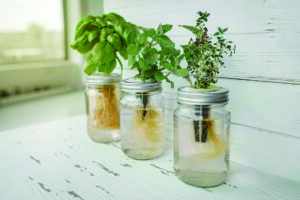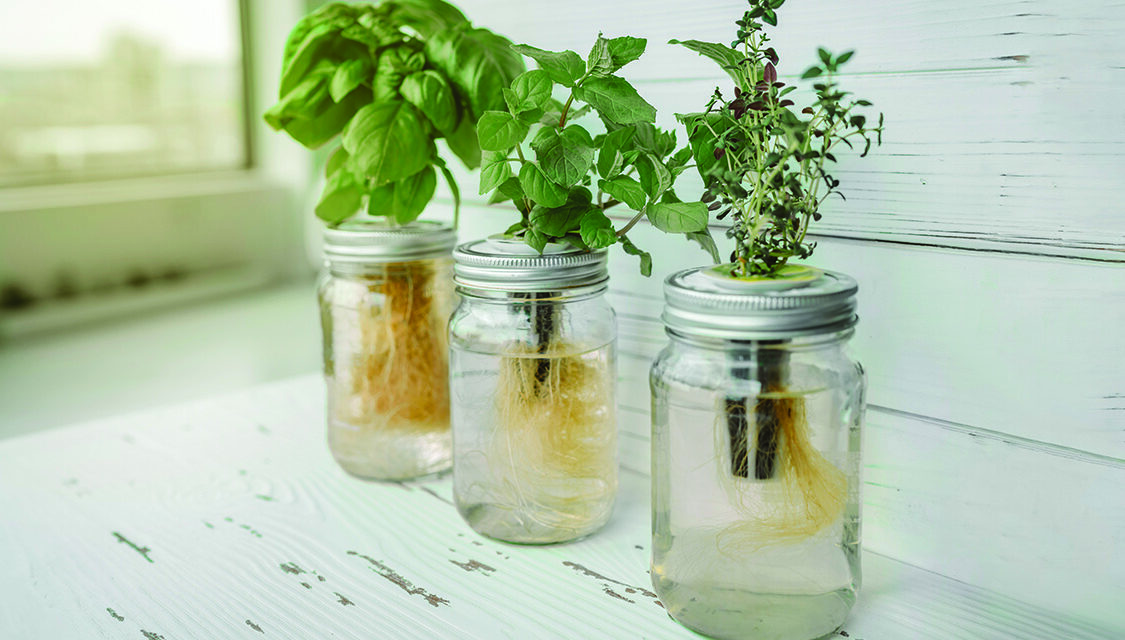
Whether one plant or dozens, passive hydroponics can keep access to fresh greens and herbs growing inside your home.
The season for indulgent holiday feasting will soon be followed by fervent New Year’s resolutions to eat healthy.
Having access to fresh salad greens grown inside your home, ready to harvest and enjoy all winter long, could provide just the satisfying, nutritious splurge to help keep that diet from going completely off the rails in December, or to get back on track come January.
Best of all, you don’t need either an indoor greenhouse or elaborate hydroponic pumping system to make it happen.
Thanks to University of Hawaii researcher Dr. Bernard A. Kratky, there’s a simple way almost anyone can sow lettuce from seed to table-ready head within just a few weeks.
Now retired, Kratky has become known for the passive hydroponic method of growing lettuce he developed now bearing his name, “The Kratky Method.”
Instead of electricity, pumps, timers, computers or other technological supports essential for operating conventional hydroponic growing systems, Kratky’s method needs just a few basic elements to be successful.
Among his simplest prototypes is the suspended net pot method, which he characterized as “a unique and powerful technique for growing leafy, semi-head, and small romaine cultivars, because the entire crop can be grown with an initial application of water and nutrients. After planting or transplanting, no additional labor is required until harvesting.”
Not surprisingly, Master Gardeners and university Extension educators have given their green thumbs up to Kratky’s method as an accessible first foray into hydroponic growing.
Penn State Extension Educator Glen Bupp explained the differences between active and passive hydroponics in a 2020 article, Simple Hydroponics.
Both methods effectively meet the prerequisites of supplying plants with the same light, air, nutrients and water found in soil-based gardens.
But the active water-based growing systems used for larger scale indoor farming require pumps, aerators, or timers, often operated with what Bupp called a “finely calibrated computer sensor that monitors the whole system.”
While such an investment may be worthwhile for a bigger operation, it can intimidate and frustrate beginners with simpler needs. For those growers, the Kratky Method makes sense.
“In passive hydroponics a plant’s ability to suck up water is utilized to drive the system,” Bupp wrote. “Effective, even attractive systems can be built from plastic buckets, mason jars, or wine bottles. As the plant grows, utilizing nutrients and water from the bucket (or other container), water level decreases pulling air down into the system to keep roots aerated.”
Robert Cook, a University of Maryland Extension Master Gardener in Baltimore, reported on his own successful efforts in a January 2022 Maryland Grows blog post titled, “Lettuce in the Midst of Winter.”
Initially learning about the Kratky Method from a fellow Master Gardener over lunch, Cook said he has been successfully harvesting homegrown lettuce for the past three years by repurposing plastic coffee bins and shoeboxes.
Among just a handful of items needed to begin growing are a container, grow light, net cups, growing medium to hold the base of the plant, and seeds, Cook advised, offering helpful caveats.
“A plastic coffee bin works well for one lettuce plant. A plastic shoebox will hold two,” Cook wrote. “To discourage algae growth, the container should be opaque. If you use a clear plastic shoebox, spray paint the outside or wrap it in aluminum foil or paper. Using a doorknob drill bit, drill a two-inch hole in the container’s lid, this will be just wide enough to hold the net cup.”
Net cups, small containers with slits along the sides and bottom, sized and designed for hydroponic use, provide a growing medium cube and seed holder.
Available for purchase online, they are reusable; “a bag of 50 net cups will supply a neighborhood full of gardeners,” Cook added. “Or, make your own net cup by slicing slits in the side of a 3-ounce Dixie cup and poking a few holes in the bottom.”
Noting that professional growers often use grow cubes made from spun glass fibers to hold the seeds or seedlings, Cook noted that he found Jiffy-7 pellets also did the trick. He also shared an improvised alternative.
“I just formed a cup from a scrap of newspaper, added some soilless growing mixture and fit that into the net cup,” he mentioned in the blog post.
Cook’s lettuce of choice to grow hydroponically is butterhead, while noting that other varieties, especially those developed for water-based cultivation, should work as well.
“The Kratky system creates light, delicate leaves with crunchy, moist ribs,” he added, noting that while the heads will likely be smaller than those grown in outdoor garden soil, they’re table-ready faster, roughly four to five weeks in his experience.
Bupp’s article added several caveats, among them, taking special care that planting materials and growing medium are sterile from the outset, having no contact with any soil or soilless environments.
Picking the right type of plant to grow is another crucial component for success.
“Plants such as lettuce, kale, and non-woody herbs whose leaves are harvested frequently or all at once after several weeks in the system grow well in passive hydroponics,” Bupp wrote. “Plants that are harvested after fruition, such as cucumbers or tomatoes, are not good candidates for passive hydroponics because nutrient levels must be closely monitored and changed throughout the life of the plant for a good harvest.”
This also rules out long-lived plants and perennials, he added, which can outgrow the original set up, he added.
While Cook noted using tap water, Bupp cautioned that it can contain chlorine and recommended letting it sit for at least 24 hours first or choosing distilled water instead.
Both growers recommended testing hydroponic nutrient solutions with a pH level of 5.5 to 6.0 to best facilitate crucial nutrient intake. Two teaspoons of white vinegar per gallon of water will do the trick, Bupp noted.
Even with a sunny window, Indoor systems will likely need additional lighting, they said.
“LEDs are more expensive to start with, but they last longer than fluorescent tubes, which should be replaced every couple of years. LEDs also provide a wider light spectrum with less heat. I like the LED strip lighting that looks like the old shop fluorescent fixtures. These are less expensive than the boxy LEDs sold to commercial growers and seem to do a great job,” Cook recounted.
Cook and Bupp’s full articles are available at:
https://marylandgrows.umd.edu/2022/01/31/lettuce-in-the-midst-of-winter/?amp=1 and
https://extension.psu.edu/simple-hydroponics, respectivley.
Kratky continues to upload videos on basic and more complex cultivating on his own YouTube channel, Kratky Grows.




